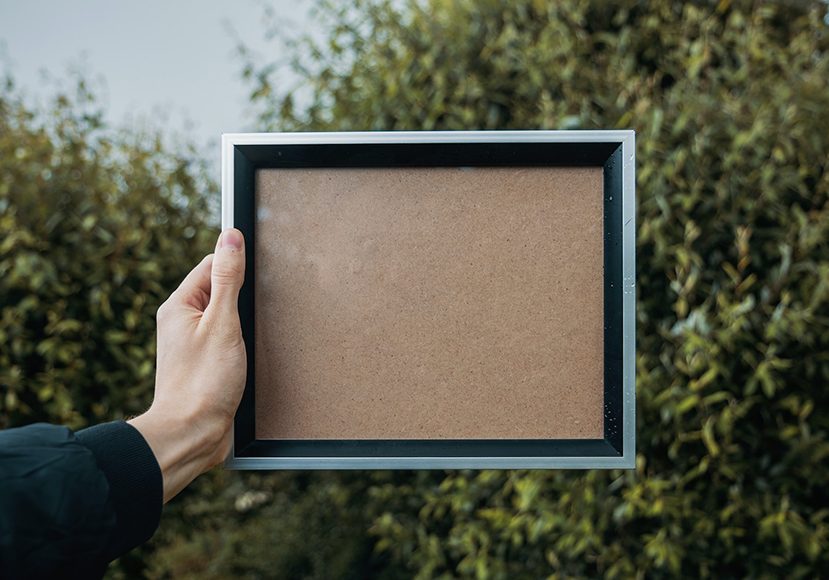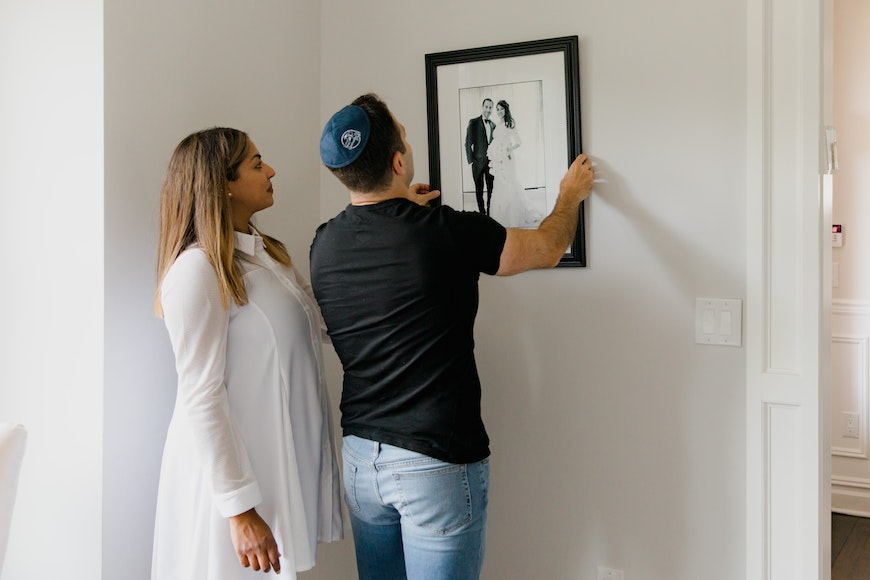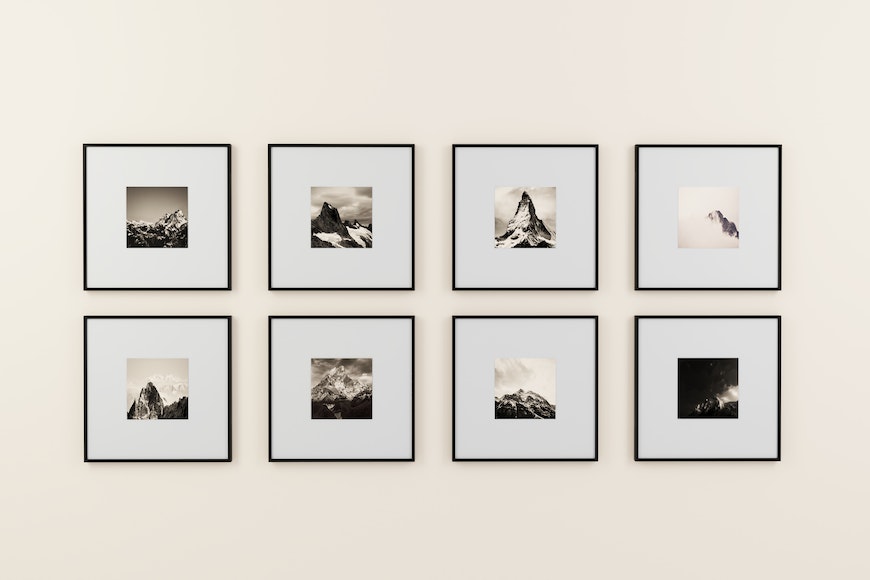
Finding the Right Frame & Mat Dimensions for Prints
A quick and easy guide to finding the right frame and mat dimensions for all your photo prints - no frame or mat size calculator needed!
By Jeff Collier
The magical thing about artwork is it does not have one standard size; it comes in many shapes and sizes.
Ultimately there is no single picture frame and mat dimensions for common print sizes, and the one you choose depends greatly upon your style, space to hang it up, and the image.
Picture frames and mats enhance the art print or photograph, making it easier to display and show off in your home.
Framing print without a mat board is simple and can be placed in the perfect picture frame size which is the same size as the print and hung up or displayed.
However, many people prefer to have their photos and art prints matted to add another dimension to the look of the image.
Continue reading to learn more about the tips and tricks I have learned over the years on correctly measuring and determining the best dimensions for picture frames and mat boards.
How Do I Choose the Right Size Picture Frame?

Credit: Rodnae Productions
Framed photos and art prints are a way to make a home, office, or other space feel more welcoming and can help personalize a space to your style and personality.
When selecting picture frames and mats for your photos, it is essential to consider the space you have, the colors in the image, and the size of the photographs.
Remember, when photos do not match the correct picture frame or mat size, they can look off-balanced, out of place, or look as if something doesn’t look right.
In addition to frame and mat size, which we will dive deeper into below, there are several other factors to consider when selecting the perfect picture frame for your photographs and art prints.
Some of the most important tips we can share with you about choosing the right picture frame include the following:
- Photo Type: Consider the photo’s subject; for example, a family portrait may look best in a larger size with a simple frame, while a landscape image may look best with an intricate frame.
- Space: Consider where you plan to place the framed photograph, such as where you will hang it, where it will sit on a desk or shelf, or what room it will be proudly displayed in.
- Matting: If you plan to add matting, it will affect the picture frame size depending on whether you use a thin or thick mat and the original size of the image.
- Measure: Take multiple measurements of your space, where the photo will hang, and the image to ensure you have all the correct measurements.
- Bring the Photo: When going to the store to pick out a picture frame and mat, bring the photo or a copy of it with you to help determine the size, mat color, and what will complement the look of the image.
Common Print Sizes
Though several common frame sizes are available, two of the most vital things to consider when purchasing the print, mat, and frame are the paper size and print size.
The paper size refers to the size of the paper you will be printing your image on, while the print size refers to the actual size of the image on the paper.
For example, most prints have white space around the image, such as a 7 x 9 image printed on an 8.5 x 11 sheet of paper.
Once you have determined the print and paper size, it is time to shop for and select a mat and frame.
Common frame sizes to accommodate print with a mat include the following measurements:
- See also: What are the best glass photo prints?
To Mat or Not to Mat

Credit: Medhat Ayad
Not all picture frames require mats, and not all images look good when matted in a picture frame.
This leaves the question: “To mat or not to mat?”
Though most art pieces, photos, prints, drawings, or watercolor paintings look better with a mat, there are some exceptions where it is not best to use a mat within the picture frame.
For example, large-format photography and prints look amazingly unmatted because the image has a more significant impact. A mat could distract from the quality of the artwork or photograph.
Additionally, when framing multiple pieces, such as diptychs and triptychs, it is best to frame size the images without a mat for a tighter, more cohesive story because this style of print is meant to be read as a single piece.
How to Choose the Right Mat Size
Choosing a picture frame size and mat for a photograph or artwork may sound simple; however, it can be trickier than you may think.
Determining the best mat size and opening for a print or photograph is often confusing, especially among novice framers.
Two main measurements are associated with mat boards – mat size and mat window.
The overall mat size is the outside measurement of the mat board, while the mat window measurement is the size of the opening in the mat where the image is seen.
Here are some tips on how to choose the right mat size for your photograph, image, or artwork:
- The overall mat size should fit snugly in the frame without any wiggle room
- Do not worry if the dimensions of the opening exactly line up with the print or image’s border
- The opening’s dimensions should be large enough to show the entire image but not too large that you can see the blank space bordering the print
- A little bit of overlap of the mat can help keep the print in place within the frame
- The recommended mat border is between two and four inches unless you want a different look
- For most prints, the mat has the same border depth, but some more art prints may look better with varied mat dimensions
- Buy a customized mat or cut one yourself for more flexibility in measurements
For example, a 16-inch x 20-inch frame size with a pre-cut mat for an 11-inch by 14-inch print or photograph will typically have a mat window opening measuring approximately 10.5 inches x 13.5 inches.
Mats come in many colors, and the color you choose for your print’s mat can play a supporting role in how it looks when on display.
Common colors tips for when selecting mats to use with prints and photographs include the following:
- Bright and bold colors create an impactful look for black-and-white photography
- Use a double mat coniguration with varying openings in complementary colors to create a layered look
- Select a color that brings out a color that is not the predominant color in the image or print
- If in doubt, choose a neutral color, such as a white mat, or colors such as ivory, tan, or gray shades
See also: How big can you print a photo?
What Are the Most Popular Frame Sizes?

Credit: 隔壁光头老王-wangmingphoto
It may seem challenging to find the perfect frame size; however, luckily, many standard frame sizes with mats accommodate some of the most popular image and picture sizes.
Some of the most standard frame sizes, with mat openings to accommodation various image sizes, include the following:
Though the measurements listed in the above table are some of the most commonly purchased picture frames with or without mats to fit various-sized prints, several other popular print and frame sizes are available.
Some of the other commonly used picture frames for prints and photographs include the following (all sizes are in inches):
- 11 x 17
- 13 x 19
- 18 x 24
- 20 x 24
- 20 x 30
- 24 x 36
Non-Standard Frame Sizes

Credit: Naveen Darzz
Though many standard frame size and mat sizes are available, not all art print sizes, photographs, or prints will fit in these picture frames.
When framing your photograph, consider the unique size of your image and look for a frame size and mat to match the size of your image.
You may have to order a custom-cut mat board to match the image and frame size, or you can cut your mat.
Common custom matting is for prints that do not fall within the standard sizes, such as poster sizes, or an artwork size requiring two mats, stretched canvas, or images that are not common photo printing sizes.
Non-standard frame sizes are not commonly found in most frame stores and are not designed to fit the most frequently ordered print sizes.
Additionally, non-standard picture frames can include designs to accommodate square, oval, or round images.
Some of the most commonly ordered or purchased “non-traditional” frame sizes include the following:
- 5 x 5
- 6 x 6
- 8 x 8
- 10 x 10
- 12 x 12
- 14 x 14
- 16 x 16
- 18 x 18
- 20 x 20
- 24 x 24
- 28 x 28
- 30 x 30
- 36 x 36
Other non-standard frame sizes include custom frames up to 40 inches by 40 inches and panoramic wood frames.
Common Frame Size Questions
Framing images and photographs is a great way to liven up a space, making it feel more inviting while proudly displaying your works of art, family photos, or other images.
Finding the correct frame size and mat size can be challenging, especially if you have images different from your typical photograph or image size.
Continue reading to see some of the most commonly asked questions about selecting custom frame sizes for your images, artwork, and prints:
What Size Frame for a 5 x 7 Print?
It is recommended to choose an 8 x 10 or an 11 x 14 frame for a 5 x 7 print to accommodate both the print and the mat.
What Size Frame for an 8 x 10 Print?
In most cases, 8 x 10 prints and images look best when matted in frame sizes of 11 x 14 or 16 x 20.
What Size Frame for a 9 x 12 Print?
An 11 x 14 or a 16 x 20 frame would work best for 9 x 12 prints and images, especially when using a mat to enhance the look of the picture.
What Size Frame for an 11 x 14 Print?
When adding a mat, an 11 x 14 print looks best in a 16 x 20-sized frame.
What Size Frame for an 11 x 17 Print?
To maintain a 3:2 or a 4:3 aspect ratio, when selecting a frame for an 11 x 17 image, it is best to choose an 11 x 17 or an 11 x 16 frame.
When matting an 11 x 17 photograph or image, the best custom frame size would be 18 x 24 to ensure an even 3.5-inch border around the image.
What Size Frame for a 16 x 20 Print?
Choosing a 20 x 24 frame with a mat is best to fit your 16 x 20 print or image.
Other FAQs
Should a frame be the same size as the print?
In most cases, picture frame sizes can be the same size as the print, except for whether you plan to use a mat to outline your image.
The picture frame size you select shouldn’t be any larger than the picture’s size or the mat’s outer border because it would look odd or off-balanced if there were any blank spaces between the frame and the mat or print.
How wide should a mat be around a print?
A mat should be between two and four inches thick around the entire picture or image.
Selecting a mat with equal measurements on all sides does not overwhelm the image and is a more traditional look.
Will a 4×6 picture fit in a 6×4 frame?
Since photo prints are typically measured and presented with the width and height, a 4 x 6 image would be four inches wide by six inches high.
On the other hand, a 6 x 4 image would be six inches wide by four inches tall.
Though they are different in orientation and measurements, they can be placed in the same frame and mat—the only difference is how the frame is displayed – horizontally or vertically.
So, ultimately, a 4 x 6 picture will fit in a 6 x 4 frame size, as long as the frame is hung to accommodate the outside dimensions of the image.
Are normal pictures 4×6 or 5×7?
The most popular photograph sizes are 4 x 6 and 5 x 7, with 4 x 6 being the standard size when having pictures printed at a photo finishing location.
A 5 x 7 print is a standard photo size, and many picture frame sizes with mats are available to accommodate this size and 4 x 6 prints.
What size is a panoramic picture frame?
When framing a panoramic picture, picture frame sizes can vary from 8 x 16 to 16 x 40 inches. Or in some cases, the picture frame sizes can be larger to accommodate the print and space where it will be displayed.
Choosing an extra wide frame to accommodate the panoramic print and a large enough mat border is best.
What size photo frame is A5?
An A5 frame measures 5.8 inches x 8.3 inches.
What size print will make my digital image look good?
Printing full-resolution digital images with 300 ppi (pixels per inch) provide the best quality prints.
Selecting 300 ppi, or sometimes 240 ppi, provides the best configuration for optical quality prints on most printers.
See what the difference is between DPI and PPI.
Final Words
When selecting mat and picture frame sizes for your artwork and photographs, there are many things to consider.
Let us know if you are still looking for the perfect mat and ready-made frame combination for your images.
We are here to help you find the best display items for your favorite art and photographs.


Check out these 8 essential tools to help you succeed as a professional photographer.
Includes limited-time discounts.













